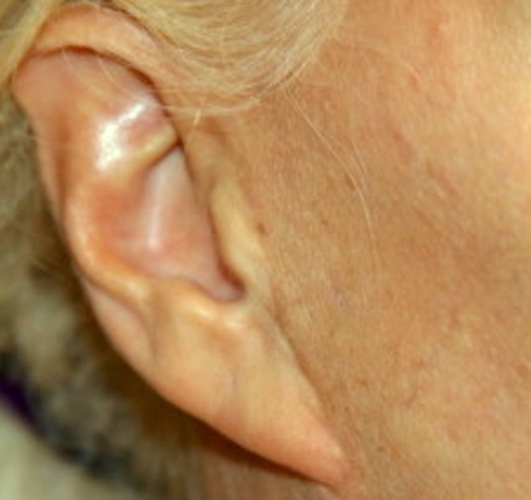- Pixie ears are a tell-tale sign of having had a facelift.
- This defect occurs when too much tension is placed on the ear after the procedure.
- Surgeons have developed numerous methods over the years to address pixie ears.
- In rare cases, pixie ears can be congenital.
Like bunny lines and trout pouts, the pixie ear is another in a long line of cutely named tell-tale signs of cosmetic procedures. Unlike ear pointing, a procedure dedicated to turning ears from ordinary to elf-like, this trend is not voluntary. Pixie earlobes are often the direct result of a poorly executed facelift.
Although this complication is not all that common, it happens frequently enough to warrant serious research. In fact, researchers have developed numerous methods over the years for preventing and correcting facelift-related pixie ears. In this article, we explore how facelifts can lead to this ear deformity and what research tells us we can do about it.
What is a pixie ear?
A pixie ear is characterized by a pulled or tethered earlobe that appears attached to the side of the cheeks rather than free-hanging.
What causes a pixie ear?
Pixie ears can be a congenital deformity, meaning you are born with the issue. More commonly, though, they are the result of an overzealous facelift.
When cosmetic surgeons perform facelifts, they smooth out your facial skin and remove excess skin. However, sometimes they remove too much. When this happens, the remaining skin struggles to cover the face, leading to downward tension resulting in a tethered earlobe.
Pixie ears were very common with older facelift methods. Subcutaneous facelifts—the original facelift—focused on just the skin. They lifted and pulled the skin across the face, leaving underlying muscular structures intact. As such, the skin bore all of the tension, leading to pressure on the ears.
Because newer facelift techniques incorporate the underlying tissues into the facelift, much of the pressure on the skin is relieved, reducing the risk of a pixie ear. That said, pixie ears can still result if too much skin is removed.
“It’s caused by excessive tightness of the skin being pulled after a facelift,” says Dr. Samuel Lin of Boston Plastic Surgery. In other words, your cosmetic surgeon made your skin too tight, placing undue tension on the earlobe and causing it to get pulled taught.
» If you’re interested in getting a facelift, but you’re concerned about risks involved, meet our medical review team for detailed information about how this procedure works.
Pixie ear correction
Don’t worry if you notice that a pixie ear has developed sometime after your facelift. There are a variety of methods to correct the problem. The practice has been refined over the years, so talk to your surgeon about your options.
Early revision
In 1982, a group of researchers, reportedly for the first time, described a minimally invasive pixie ear revision surgery. Their process involved creating an incision over the facelift scars. With this incision, they surgically reshaped the earlobe, detaching it from the side of the head. They then stitched up the side of the head separately from the lobe. However, this method was far from perfect, and resulted in substantial scarring.
“YouTube” Method
This method is based on the idea that “raw edges” of skin will form a tube on their own during the healing process. In other words, the surgeon doesn’t need to shape the earlobe; it will essentially shape itself when freed from the head. This “autotubing” occurs a few weeks after the cosmetic surgery.
Triangular incision
This more recent method addresses pixie ear simply and with minimal scarring. It involves taking a wedge of skin from the back of the ear, which relieves tension on the ear and separates the lobe portion from the head.
Revision deep plane facelift
Like SMAS facelifts, deep-plane facelifts address deeper tissues. However, instead of separating the skin from the muscle, skin and muscle are taken together to adjust the face. When done as a revision surgery for pixie ears, it can relieve the tension on the skin by placing that tension on deeper layers.
MACS facelift
A 2013 case study looked at a 53-year-old woman who’d had a facelift procedure that resulted in a pixie ear. Dissatisfied with her postoperative appearance, the woman sought corrective surgery. The surgeons performed a minimal access cranial suspension (MACS) facelift with a small modification. The traditional MACS facelift is a mini lift that targets deeper tissues in the face. The surgeons performed this traditional MACS facelift but added a purse-string suture at the end to prevent the earlobe from returning to a pixie appearance.
V-Y plasty
This method is similar to the triangular incision described above. However, V-Y plasty does not remove substantial amounts of skin. It simply adjusts it. Researchers who support this method note that removing skin results in a smaller earlobe, which is cosmetically less desirable.
V-Y plasty makes a similar arrow-shaped incision behind the earlobe, where the surgeon identifies tension. In a normal V-Y plasty, this V-shaped incision is then stitched into a Y-shaped pattern by shifting the placement of the skin. However, for pixie ear revision, the top of the Y is closed with sutures, while the bottom two branches are incorporated into the facelift incision, assuming a revision facelift surgery is being performed at the same time. This method relieves tension on the area without moving unnecessary amounts of skin.
Earlobe creation
Dr. Shah has successfully corrected several pixie ears caused by facelifts by “anchoring the deep tissues of the earlobe to the perichondrium of the conchal cartilage.” In other words, he frees the earlobe and anchors it to the cartilage on the inside of the ear, which “converts it into a freely hanging earlobe and fights the natural tension of the face.” The earlobe is anchored with a small permanent suture. He’ll also redrape, or adjust, the skin around the ear to further reduce tension.
Talk to your surgeon about preferred methods for correcting pixie ear. How effective a revision surgery depend on the severity of the deformity and the amount of skin laxity your surgeon has to work with. For this reason, you might have to wait for some time to pass after the previous facelift if your skin is still too firm.
» Do you suspect that you might have pixie ear? Meet our medical review team for a consultation to determine if you have an ear deformity.
How can I prevent pixie ear?
As the saying goes, prevention is better than a cure. Many facial plastic surgeons agree and have worked to improve facelift methods to reduce the likelihood of pixie ear and other complications.
A 2009 study published in the Aesthetic Surgery Journal explored strategies to prevent pixie ears with the initial facelift. The 106 study patients received facelifts that included fat injections for facial volume, hidden incisions in the ear area, and barbed sutures that go in different directions, thereby distributing the tension in the area.
The ear position became elevated instead of pixie-like in about 70% of those patients. And 10% of the patients noted no change in their ear position. The rest did experience some lowering or pulling down of the ear. Although the study authors considered this a success, it remains unclear how effective these methods are, especially without knowing the surgeon’s track record before these strategies were applied.
Proponents of the V-Y plasty method for correcting pixie ear note that the method could be used in conjunction with an initial facelift to prevent the condition. The V-Y plasty incision prevents tension on the ear, which can help during the initial healing process.
“Pixie ear tendency can be identified during the procedure,” notes Dr. Lin, “[the earlobe] is usually the last area that I place sutures in order to see how the skin from the face appears adjacent to the earlobe.”
Dr. Shah speaks to those with already attached earlobes, who are at a greater risk of developing this complication. “I counsel them that I will convert their attached earlobes into freely hanging earlobes to prevent pixie ears,” he says. He notes that “any facelift procedure can be used as long as attention is paid to this particular detail,” but acknowledges that subcutaneous facelifts are “the only lift that runs a high risk of creating first-time or recurrent pixie ears.”
Dr. Shah also notes that patients can exercise some of their own preventative measures. He advises patients to “pick the right surgeon” and “avoid aggressive turning of the head and neck so that tension on the earlobe is reduced.”
At the end of the day, the most important preventative measure is finding a skilled board-certified surgeon who will perform a facelift that does not place too much tension on the skin.
Takeaway
After getting that long-awaited facelift, you might be more than a little discouraged to find one or both ears migrating out of shape. And it can be worrisome to hear that this isn’t supposed to, and usually doesn’t, happen. However, medical professionals have long been aware of the issue and the methods for treating it are well tested.
» If you’re ready to get your ears back to normal, talk to our medical review team about your concerns and explore how Cosmetic Ear Surgery can assist you in reaching your desired aesthetic goals.









